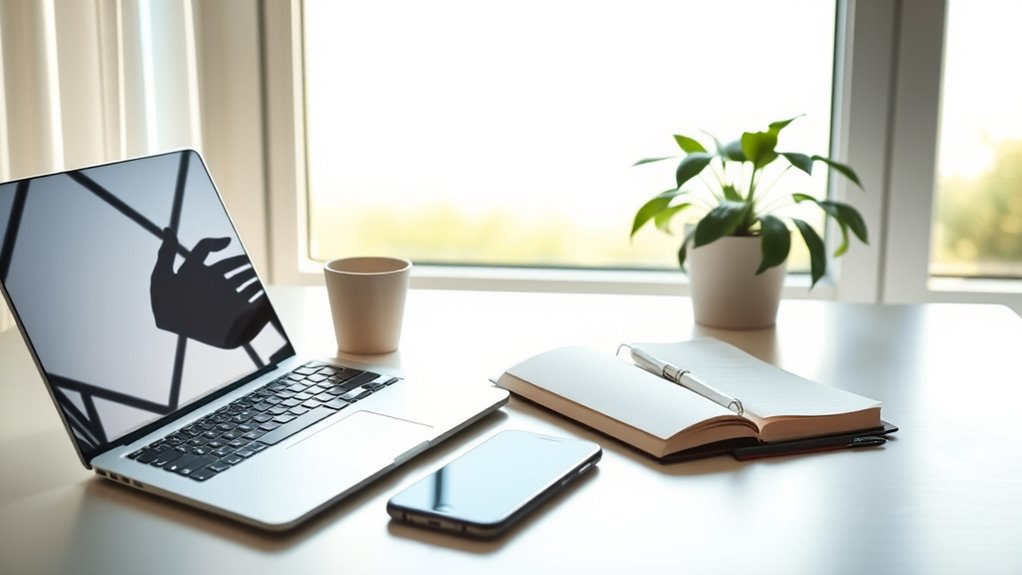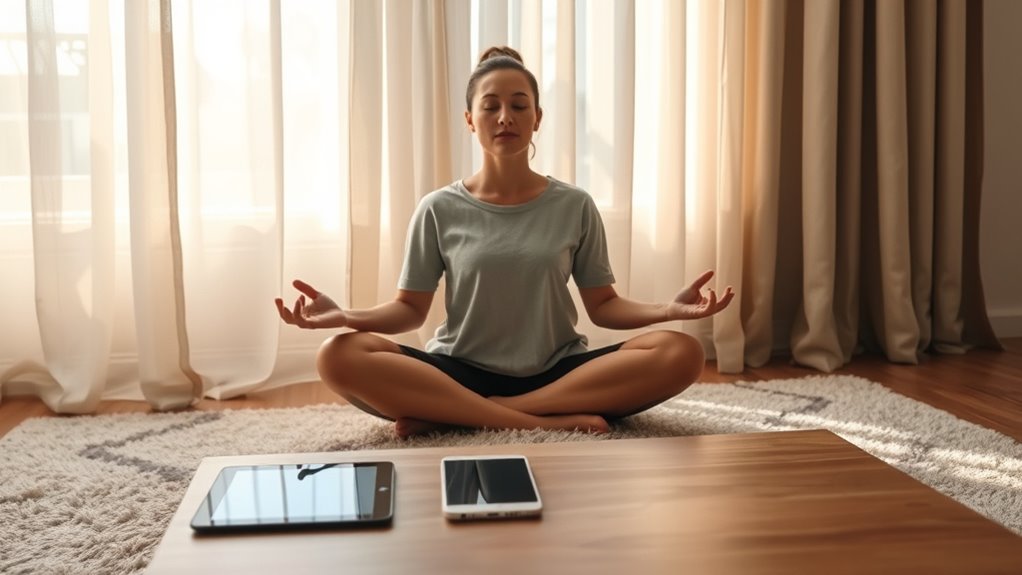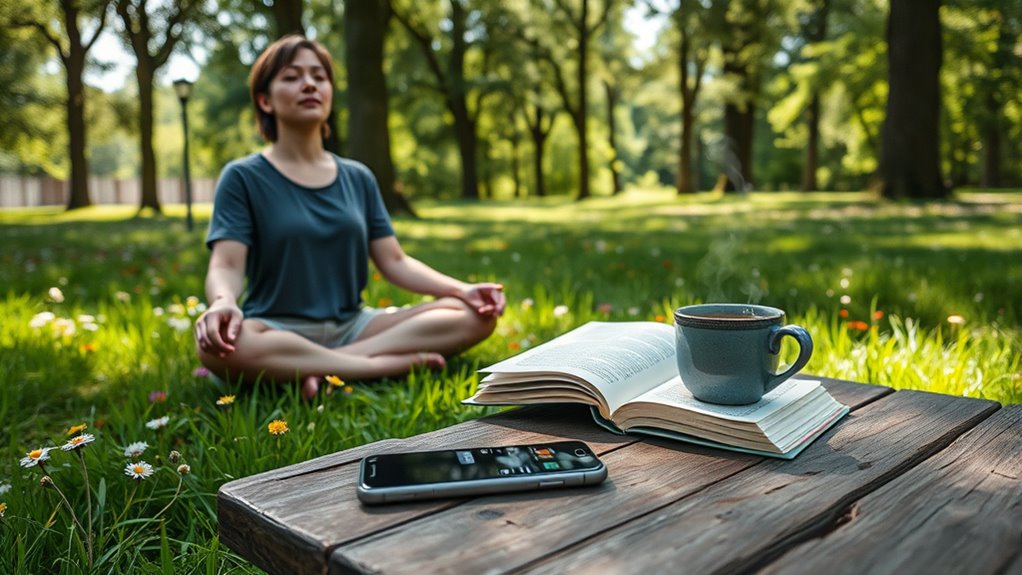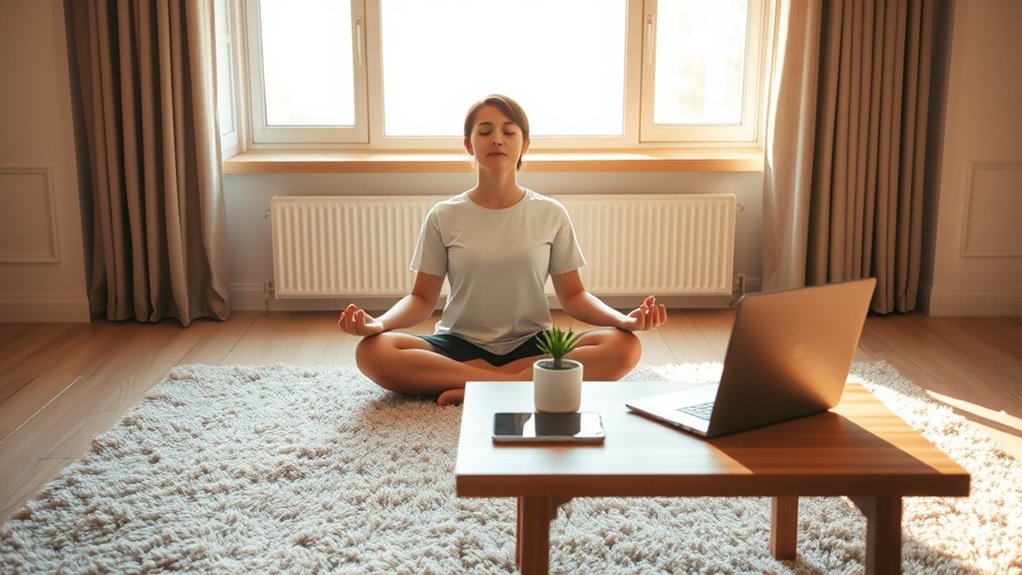To balance your technology use and protect your mental space, set clear boundaries like limiting screen time and creating tech-free zones for meals and relaxation. Practice mindful digital habits by organizing your environment, reducing notifications, and choosing content intentionally. Incorporate offline activities that foster genuine connection and creativity. Building resilience through regular breaks and self-care helps manage digital stress. Keep exploring ways to create a healthier tech balance that supports your well-being and connections.
Key Takeaways
- Establish clear boundaries and designated tech-free zones to promote real-life interactions and reduce digital distractions.
- Practice mindful digital habits by limiting notifications, unsubscribing from unnecessary content, and organizing your digital environment.
- Incorporate regular digital detoxes and scheduled breaks to reset your mental space and prevent overload.
- Engage in offline activities like hobbies and face-to-face social interactions to foster emotional resilience and mental clarity.
- Use tools like app timers and device settings to enforce digital limits and support balanced technology use.
Recognizing the Impact of Digital Overload

Digital overload happens when you spend too much time on screens, which can lead to stress, fatigue, and decreased productivity. You might notice signs of digital dependency, such as feeling anxious without constant device access or compulsively checking notifications. This reliance on technology can cause emotional exhaustion, leaving you drained and overwhelmed. You may find it hard to focus, experience mood swings, or feel disconnected from real-life interactions. Recognizing these symptoms is vital because they indicate that your screen time is affecting your mental health. When digital overload persists, it can foster a cycle of dependency and emotional fatigue, making it harder to disconnect and recharge. Being aware of these impacts helps you take the first step toward managing your digital habits effectively. Additionally, understanding how technology tuning can optimize your digital environment may help reduce some of these negative effects.
Setting Boundaries for Screen Time

Establishing clear boundaries for your screen time is essential to maintaining a healthy balance between technology use and real-life activities. Digital boundaries help you control when and where you engage with screens, preventing overuse and distraction. Setting specific limits, like no screens during meals or an hour before bed, promotes healthy habits. Practicing tech mindfulness involves being intentional about your digital interactions, recognizing when you’re mindlessly scrolling, and choosing more meaningful activities instead. Use tools like app timers or device settings to restrict your screen time. Being aware of high refresh rates in devices can also help you select technology that reduces eye strain during prolonged use. Additionally, understanding divorce process requirements in various states can guide you in navigating legal procedures if needed. By defining these boundaries, you create a mental space that fosters focus, relaxation, and genuine connection. Remember, consistent boundaries support your well-being and help you stay in control of your digital life.
Creating Tech-Free Zones and Times

Creating designated areas and times where screens are off helps reinforce the boundaries you’ve set and encourages more meaningful interactions. For example, establish tech-free mornings to start your day calmly and intentionally. Similarly, designate device-free dinners to focus on conversation and connection. These zones create space for genuine engagement and reduce digital distractions. Use the table below to help plan your tech-free times:
| Time/Area | Activities |
|---|---|
| Morning | Meditation, breakfast, journaling |
| Dinner | Conversation, family games |
| Living Room | Reading, board games |
| Bedroom | Sleep, relaxation, winding down |
Implementing active listening during these times can further deepen your connections and ensure that technology does not interfere with quality time. Being aware of cookie categories and managing user consent can also help maintain online privacy while you focus on in-person interactions.
Curating Your Digital Environment

To effectively manage your technology use, you need to curate your digital environment intentionally. Start by appreciating digital minimalism—keeping only the tools and apps that truly add value to your life. Unsubscribe from unnecessary newsletters and disable notifications that distract you. Cultivating intentional consumption means being selective about what you engage with online, focusing on content that enriches or informs rather than distracts. Create folders or categories to organize your digital space, making it easier to access what matters most. Limit your social media feeds to accounts that inspire or educate you. By intentionally shaping your digital environment, you reduce clutter and mental noise, allowing you to focus on what truly matters and protect your mental space in today’s digital age. Incorporating content curation strategies can further help you filter out unnecessary information and maintain a balanced digital diet. Additionally, practicing sound healing techniques can help counteract digital overstimulation and promote mental clarity.
Practicing Mindful Technology Use

Before you start using your devices, set clear intentions to stay focused and avoid mindless scrolling. Establish screen time limits to create healthy boundaries and prevent overuse. Taking regular digital detox periods helps you reconnect with the world around you and practice true mindfulness. Be aware that cookie management policies can impact your online experience and privacy choices. Additionally, being mindful of your screen time can help reduce digital fatigue and improve overall mental well-being.
Set Intentions Before Use
Practicing mindful technology use starts with setting clear intentions before you pick up your device. When you establish a mindful intention, you focus on why you’re engaging with your device, whether it’s to check messages, browse social media, or gather information. This purposeful engagement helps prevent mindless scrolling and reduces digital fatigue. Before opening an app or unlatch your phone, pause briefly and ask yourself what you hope to accomplish. By clarifying your goal, you make your interactions more intentional and less impulsive. Recognizing the importance of digital habits can help you develop healthier routines and avoid falling into automatic usage patterns. Developing a structured approach can further support mindful use by creating designated times for device engagement rather than sporadic checking. This practice keeps you aware of your digital habits and encourages you to use technology as a tool rather than a distraction. Setting these intentions empowers you to control your tech use, fostering greater mental clarity and balance.
Establish Screen Time Limits
Setting clear screen time limits helps reinforce your intentions and maintain mindful technology use. By applying app restrictions and managing notifications, you prevent overuse and stay focused. Use device settings to set daily time caps for apps, reducing unnecessary distraction. Notification management ensures you’re not constantly interrupted, helping you stay present. Consider a schedule that designates specific times for checking devices, aligning with your goals. Here’s a visual guide:
| Strategy | Implementation |
|---|---|
| App Restrictions | Limit usage duration per app |
| Notification Management | Turn off non-essential alerts |
| Set Daily Limits | Use device features to cap time |
| Scheduled Breaks | Designate tech-free periods |
| Review & Adjust | Regularly update your limits |
These steps keep your digital habits intentional and balanced.
Practice Digital Detox Periods
Incorporating regular digital detox periods into your routine allows you to reconnect with the present and reset your digital habits. During these breaks, focus on mindful social media by intentionally limiting your online interactions and avoiding mindless scrolling. Use this time for digital decluttering—delete unused apps, clear notifications, and organize your devices to reduce digital clutter. These detox periods help you regain mental clarity, lower stress, and foster healthier tech habits. By intentionally stepping away from screens, you create space for real-world connections and self-reflection. Regular digital detoxes are essential for maintaining mental space in today’s fast-paced digital age. Additionally, understanding the importance of digital literacy can help you develop more conscious and informed online behaviors, further supporting your mental well-being. Developing healthy technology boundaries ensures you maintain a sustainable balance between digital engagement and mental health.
Developing Offline Activities for Balance

To achieve a healthy balance between screen time and offline activities, it’s vital to actively develop engaging options outside of digital devices. Creative hobbies, like painting, writing, or playing an instrument, stimulate your mind and provide fulfilling outlets for expression. They also help you disconnect from screens and foster a sense of accomplishment. Additionally, prioritize social engagement by spending quality time with friends and family face-to-face. Participating in group activities or joining clubs can enhance your social connections while reducing reliance on digital interactions. These offline activities not only refresh your mental space but also create meaningful experiences that digital use often lacks. Incorporating mental wellbeing practices into your routine can further support emotional resilience and overall balance. Developing a vibrational energy mindset can help you attract positive experiences and relationships. By intentionally cultivating these habits, you build resilience against digital overload and nurture a balanced, healthier lifestyle.
Building Resilience Against Digital Stress

After establishing offline activities to create a healthy balance, it’s important to develop strategies that help you manage digital stress effectively. Building resilience involves strengthening your emotional resilience and practicing stress management techniques. You can do this by setting boundaries, prioritizing self-care, and practicing mindfulness. These practices help you respond calmly to digital overload and reduce anxiety. To deepen your understanding, consider this table:
| Strategy | Benefit | Example |
|---|---|---|
| Digital boundaries | Reduces overwhelm | Turning off notifications |
| Mindfulness | Enhances emotional resilience | Daily meditation |
| Self-care routines | Boosts stress management | Regular exercise |
| Journaling | Clarifies emotions | Writing about feelings |
| Support networks | Provides emotional resilience | Connecting with friends |
Implementing these strategies helps you build resilience and handle digital stress confidently. Additionally, understanding the role of attention in creative practice underscores the importance of focused engagement for mental well-being. Recognizing the importance of sound environment can also enhance your ability to stay present and reduce digital distractions.
Frequently Asked Questions
How Does Digital Overload Affect Sleep Quality?
Digital overload can markedly impact your sleep quality by causing sleep disruption. The excessive use of screens, especially before bed, interferes with your circadian rhythms, making it harder to fall asleep and stay asleep. The blue light emitted by devices suppresses melatonin production, which is essential for regulating your sleep cycle. As a result, you may experience poorer sleep, leading to fatigue and decreased mental clarity during the day.
What Are the Signs of Digital Addiction?
Imagine your phone is a magnet pulling you in—digital addiction signs appear when you can’t resist constant checking, even during conversations or work. You might notice behavioral dependence, craving screens more than real interactions, or social withdrawal, avoiding face-to-face time. When these signs take over your life, it’s a clear warning you’re becoming too reliant on technology, risking your mental well-being and personal connections.
How Can Parents Manage Children’s Screen Time Effectively?
To manage your children’s screen time effectively, set clear parental boundaries and establish consistent rules. Use educational strategies like scheduled tech-free times and engaging offline activities to encourage balance. Communicate openly about why limits matter, and involve your kids in creating these boundaries to foster cooperation. Regularly review and adjust rules as needed, ensuring they understand the importance of healthy digital habits while maintaining their mental well-being.
What Tools Can Help Monitor and Limit Device Usage?
To monitor and limit your device usage, you can use app blockers that restrict access to certain apps or set time limits for screen time. Many devices have built-in parental controls, like Screen Time on iOS or Digital Wellbeing on Android, which let you track usage and create boundaries. These tools help you stay aware of your habits, encouraging healthier screen time management and protecting your mental space.
How Does Digital Detox Improve Mental Well-Being?
A digital detox boosts your mental well-being by fostering digital mindfulness and strengthening your tech boundaries. It helps you disconnect from constant notifications, reduce stress, and regain focus. By consciously stepping away from screens, you create space for relaxation, reflection, and genuine connections. This intentional break replenishes your mental energy, enhances clarity, and restores balance, empowering you to manage technology use more mindfully and protect your mental space in today’s digital world.
Conclusion
Balancing technology isn’t about banning screens but about reclaiming your mental space. As you disconnect from constant notifications, you create room for genuine connections and peace. In a world obsessed with digital noise, choosing mindful moments offers clarity and calm. Embrace offline activities and set boundaries—because sometimes, stepping away from the screen is the most powerful way to stay connected with yourself. Remember, balance isn’t just a goal; it’s your sanctuary amid the digital chaos.









